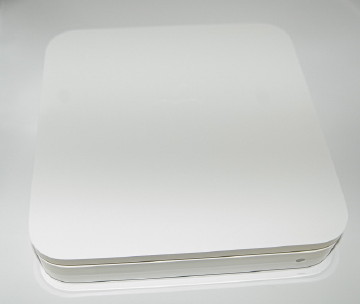
|
Bangkok Diary
|

|
|
Graham K. Rogers I was in San Francisco last January when, as well as the iPhone, Steve Jobs told us about the Airport Extreme Base Station with its enhanced speeds: it was designed using the draft IEEE 802.11n standard as well as the usual b and g specifications. But wouldn't you just know it: first the device was not going to be available for some two months, which put paid to the idea of running the couple of hundred metres to the Apple shop and buying one there; and two countries were specifically excluded from the supply-chain, South Korea and Thailand. I expect North Korea was also out, but the reason that Thailand was not on the list was because of the nature of telecomms laws here. As the draft standard had not been approved by the IEEE, it was illegal to use 802.11n here. As it was illegal to use it, Apple could not sell it. As is the nature of things, with Singapore just down the road (relatively speaking) and creative retailers, a few of the devices started appearing, along with the AppleTV that was also supposed to be unavailable for similar reasons. In March of this year (2007) there was a draft approval and within a short time, the device appeared on the price lists in the local retail outlets which about coincided with the emptying of my wallet. Come November, however, the annual bonus I was about to pick up a new telephoto lens which disappeared from the shelves just as I was ready to buy one. Plan B was the Airport Extreme base station. I bought one of these last Sunday at the new Central Pinklao iStudio, which is the newest outlet in Bangkok and the first Apple retail shop the unfashionable side of the Chao Phraya river. It is doing great business.
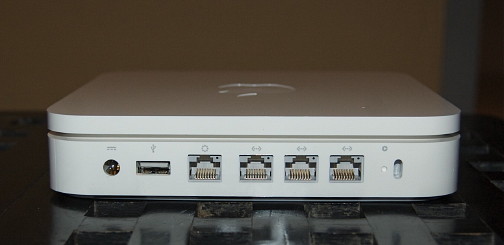
The tales about these base stations abound; and there was an increase in cries for help when Leopard was updated. I took it carefully and didn't even open the box for a few hours. When I did, I noted the contents and cursed. Inside was a plug, on the end of the cable for the power brick, that came either from Singapore or Hong Kong -- the same heavy three-pin, earthed plug, with the oversized brass pins that can be found in every home in the UK. Here, the plugs have two thin pins, so an adapter is needed. I have one at home now and that is for the coffee-grinder. There are priorities: I had lived without WiFi for months; the modem-router and its Ethernet cables were working fine; and I could not imagine starting a day without coffee. This could wait. The power brick resembled the ones that came with the three Mac minis I had bought for some students to use, although it was a little smaller. I checked the manufacturer and these were made in China, while those for the minis had been out of the Delta Electronics factory in Samut Songkram: not too far from here. I was impressed with the amount of cable that was available. About a metre from the plug to the power unit, and then another two or more metres from there to the base station itself. This would give an unusual amount of flexibility in the unit's placement, although in the end I opted for the table right next to the modem/router.
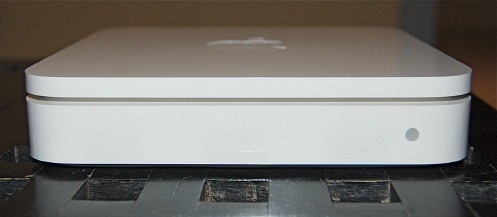
Come Monday night I weakened. I also found a plug which I could attach the coffee grinder to: it would work as long as I held the cable. In the previous few hours I had read the small manual a couple of times and had collected all my networking knowledge. I had noted during that first look inside the box that the envelope containing the paperwork and the disk had a label on it, "Install software before connecting base station", although someone in a rush might miss that. I am always pretty cagey about any new software or hardware like this, so I quit all applications that accessed the internet and went through the motions of a permissions repair using Disk Utility first.
I had read the manual, I had checked the system and I was taking notes. I always tell my students to do this, for the idea of (Newtonian) repeatability; to see where I have gone wrong (or right); and to make it easier when it comes to writing. Oten -- and I hate to admit this -- this stuff almost writes itself. I also took the rare step of logging out from the User account and opening the Admin account to do the install. Seeing that label on the envelope about installing the software first had imparted a certain gravitas. On inserting the disk I noted that three PDF files were visible. I had already seen the handbook as this was in the box in paper form, but the one on Designing Airport Networks was far more valuable and that should have been in the box too. Onscreen PDF access is never as effective as print, especially if the screen is being shared with an installation program.
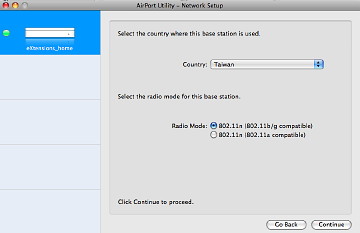
I also selected a connection type that would make the base station itself allocate IP numbers. The alternative, Bridging Mode, would be unsuitable for my system.
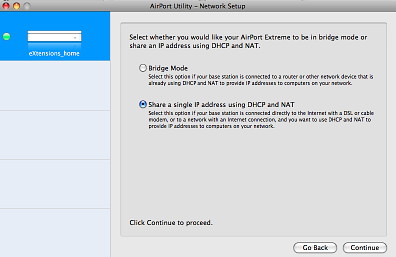
The base station restarted, but initially reported that there was a problem and trhere was no IP address. The device was shown onscreen, then a panel appeared with the simple, but encouraging message, "OK". A second message followed to show that the problem had been resolved and immediately, the base station power light changed to green. In System Preferences, the Network information was also updated and the Aiport was shown as "Connected".
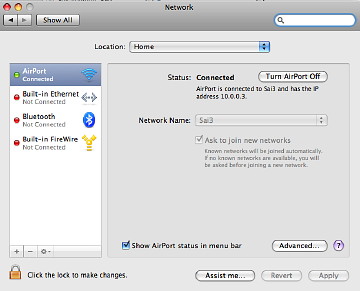
I returned to my User acount as this was where I would be doing all work normally. Although the system was working at this time, when I subsequently restarted the device and then logged in to the User account, it asked for the WPA2 password. Since then, as it is in the Keychain Access data, I have not been asked again. I checked Mail and that was able to send and receive properly. Safari was OK, but a little slow. A check with ADSL Thailand later revealed that local connections were fine, but links to sites outside Thailand were slow: not unusual, particularly late evenings. A check with Speakeasy as I write this shows 1736kbps download and 378kbps upload which is what we get on a good day with a tail-wind. Continuing the checks, the iTunes Music Shop was problem free -- not that we can buy anything from there in the Land of Smiles -- and Adium too (my MSN substitute in this Microsoft-free environment) was firing on all cylinders.
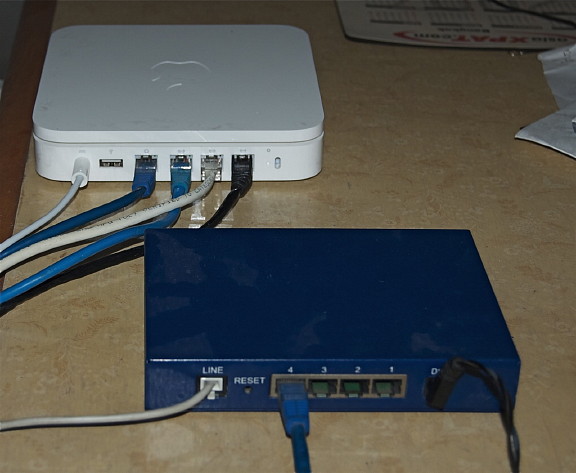
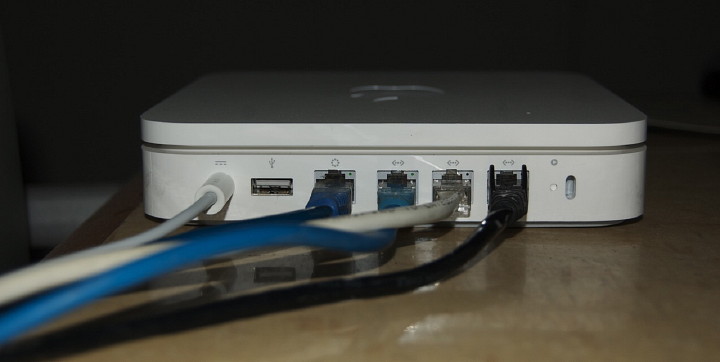

We have had four days of undisturbed operation, depending on how good the external links to the system are. The strength of signal shown on the computer is usually four bars of the Airport menubar item; and the eMac upstairs that is connected via an Ethernet cable to the base station didn't blink. As a (fairly subjective) test, I walked outside with the Mac. The area has a fairly heavy cover of trees, so this would affect signal strength as well as the concrete structure of the house. From about 50 metres, the strength was still showing as four bars. Any further and the signal fluctuated, but despite not showing any strength, I was still able to check mail and access both the Apple website and my own pages on the internet sitting outside a local restaurant in the moo bahn (estate).
|
|

For further information, e-mail to
Back to
eXtensions
To
eXtensions: 2004-05
To
eXtensions: Year Two
To
eXtensions: Year One
To
eXtensions: Book Reviews
Back to homepage